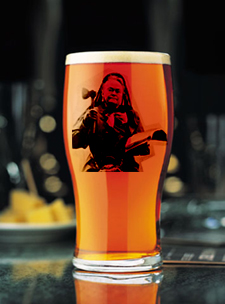|

Dutch Courage: A History
of Booze in America
(continued)
By Joan Schonbeck
Temperance organizations were the parents of the feminist
movement. It was the banding together of women in these anti-drinking
organizations that gave them a greater opportunity for exchanging ideas
and ideals. The male-supremacist Washingtonians were one inadvertent
catalyst. While a member of the Washingtonian Women's Auxiliary, Susan
B. Anthony became fed up with the group's macho attitude and led the
rest of the auxiliary away to form a splinter group. In 1874, in a Cleveland,
Ohio, church basement, another feminist, Elizabeth Cady Stanton, founded
the organization destined to be on the cutting edge (literally) of the
temperance movement, the Women's Christian Temperance Union, affectionately
called the WCTU.
Long before she wrote Uncle Tom's Cabin or was
called by Abraham Lincoln "the little woman who started the big
war," Harriet Beecher Stowe was penning anti-alcohol literature.
Even Amelia Jenks Bloomer, before an obsession with pants got in the
way, was a vocal temperance advocate. But all of these pale in comparison
to the plain, raw-boned woman in her black dress and poke bonnet, hatchet
in hand, who became America's most enduring symbol of the temperance
movement: Carry Nation. She was born Carrie Moore on a plantation in
frontier Kentucky in 1846. Its been said that insanity did not run in
the Moore family — it galloped! Carrie's mother, convinced that
she was Queen Victoria, flounced around in purple velvet robes and tiara.
Shades of "Folie a Deux," Carrie's long-suffering
and devoted father had a special queenly coach built for his wife, and
set several of the plantation slaves to work as costumed outriders accompanying
"The Queen" on her jaunts through the Kentucky countryside
to survey her domain. But it didn't stop there. One of Carrie's aunts
often clambered onto barn roofs, convinced that she could turn into
a weathervane at will. What sanity young Carrie possessed seems due
to being "banished" to the slave-quarters for most of her
childhood by her mother, "The Queen." But even so, little
Carrie "saw visions" and "heard messages." Destiny
would make her madness different, more focused. At the age of twenty,
Carrie fell madly in love with an older man, Dr. Charles Goyd. Naive
infatuation could not long disguise what Dr. Goyd actually was: a chronic
alcoholic.
After a few years of marriage, Goyd died of his illness,
but not before Carrie had begun to do all the things people we today
call "co-dependents" do. She nagged, scolded, supported, and
covered up for him. Increasingly depressed and isolated, she began to
follow him to bars and blame others for his drinking. Around the time
of Goyd's death, Carrie's visions and voices, interestingly absent during
the years of her marriage, returned. This time, though, they had a more
specific message. She married a second time, to an itinerant preacher
named David Nation, and legally changed the spelling of her first name
so that she became "Carry A. Nation" — a sign of things
to come.
From her first sortie against a gin-mill in Medicine Lodge,
Kansas, in 1899 until her death in 1911, Carry and her WCTU followers,
hatchets and bricks in hand, "trashed" drinking establishments
from Texas to New York City. (At one saloon in New York she ran into
her grandson, tending bar). She regularly challenged tavern owners (and
once, John L. Sullivan) to "step outside." With superhuman,
maniacal strength, she hurled beer barrels out of windows and tore icebox
doors off. Frequently, she sported black eyes and was regularly imprisoned.
But absolutely nothing ever stopped her. Carry and her hatchet became
better known than the president. She was an international celebrity.
Offers of everything from the lecture circuit to wrestling Montana grizzly
bears poured in from all over the country. (Carry stood six feet tall,
and weighed in at 180 lbs. of pure muscle.)
Her insults to tavern owners and their customers, judges
and sheriffs were legendary. No judge ever sentenced her for saloon
mayhem without hearing Carry say sweetly, "Thank you, Your Dishonor!"
Gin mills under attack rang with her frenzied shouts about "Joints,
rummies, murderers and hell-holes!"
Smoking was another of Carry's aversions. Routinely, as
she strolled down the street or raided a bar, cigars and cigarettes
were snatched from the mouths of unsuspecting males and stomped into
the ground. It's a genuine tribute to the chivalry of 19th century American
males that Carry sustained no more serious injury than several shiners.
She even published a newspaper, The Smasher's Mail, which democratically
included nasty letters from drinkers and bar-owners in a section entitled
"Letters from Hell."
Carry and the "ladies" of the WCTU were a loud
and surprisingly effective lunatic fringe of the temperance movement.
But the support that followed their twelve-year vendetta against the
bars came from a quieter, seemingly more sane section of American society.
In 1903, machinist Henry Ford set up his automobile-building company
in Deerborn, Michigan. His life-long campaign against booze, begun then,
seems more based on economics than morality. He and other American tycoons
began to put a dollar value on alcohol abuse, and envision a utopian
America where no one drank. It would be a place without hunger or poverty,
battered wives or neglected children.
Cars and other products would be made with sober skill,
and everyone would have a bank account. Like secret police in some dictatorship,
Ford's "Sociological Department" spied on employees, even
visiting their homes to check on their habits. Drinking, at worst, could
earn Ford employees dismissal, at best, a reduction in wages. In like
manner, the Reo Motor Car Co. hired private detectives to report anyone
who drank, smoked or voted against prohibition in elections. By 1917,
most companies, including the major railroads, had regulations on the
books banning the use of alcohol on the job. An early advocate of total
prohibition, Henry Ford assured the country that alcohol wouldn't go
to waste. With remarkable vision he stated that alcohol was "the
fuel of the future."
 
|